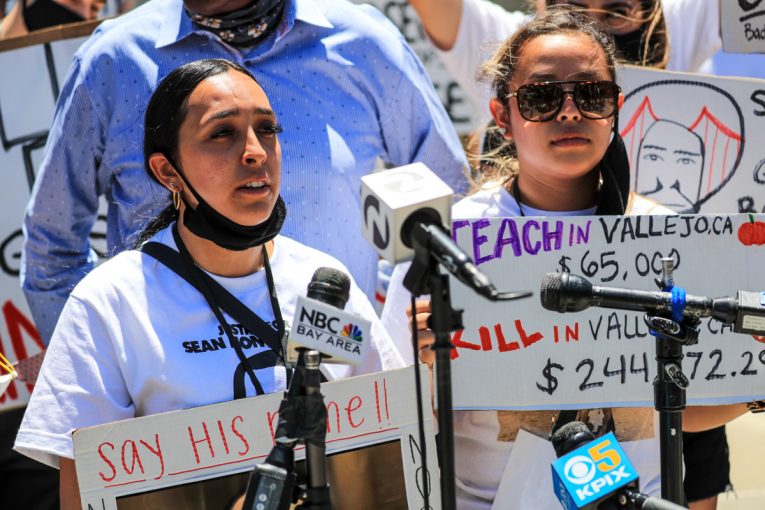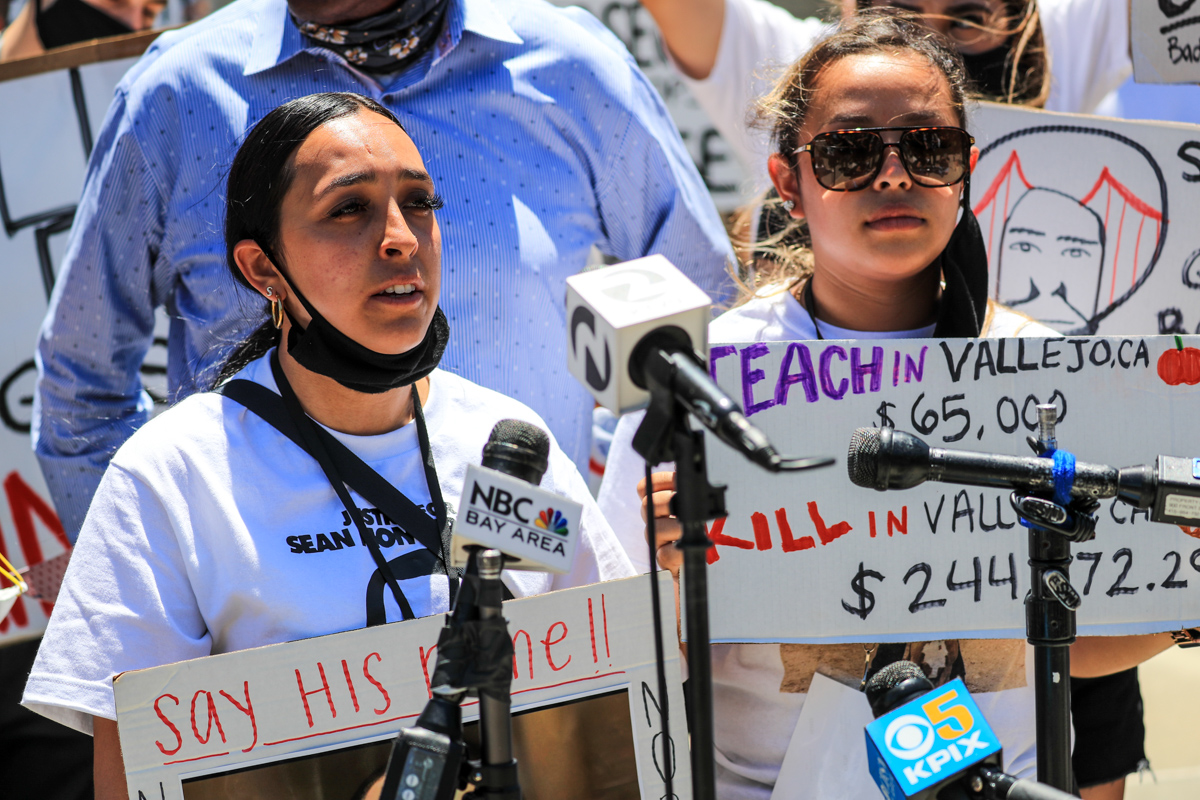

By David M. Greenwald
Executive Editor
Vallejo, CA – Disappointing. With the worldwide attention on the death of George Floyd, the quick prosecution and significant conviction, it seemed like there was a new era dawning in police accountability.
But compare the situation in George Floyd to the shooting death of Sean Monterrosa just a week later—during a time when protests and riots were occurring in response to Floyd’s killing.
Here we are three and a half years later and the California Attorney General—after the local DA punted on the case—has closed the investigation without filing criminal charges.
While Keith Ellison, the Minnesota Attorney General, has earned admiration and praise for his office’s prosecution of Derek Chauvin, his counterpart in California, Rob Bonta, looks weak and ineffectual in his office’s report.
Bonta will open himself to charges that perhaps he was more interested in running for governor in 2026 than he is in doing justice in this case.
The attorney general concludes that “there is insufficient evidence to support criminal  charges against the involved officer. Sean Monterrosa was shot and killed by an Officer with the Vallejo Police Department (VPD) on June 2, 2020.”
charges against the involved officer. Sean Monterrosa was shot and killed by an Officer with the Vallejo Police Department (VPD) on June 2, 2020.”
The concern of course is the police assumed that Monterrosa “was carrying a firearm concealed in his clothing” and this was based on a warning from an undercover officer as well as “the way Monterrosa was running.”
Monterrosa suddenly stopped and turned to face the officers.
Officer Tonn, who would shoot and kill Monterrosa, told investigators that as Monterrosa turned, “(He) Tonn saw him grabbing at an object in the area of his waistband.”
Tonn stated that he believed the object was a gun. Tonn fired five shots from his rifle through the windshield at 12:36:36 a.m. One of these shots struck Monterrosa in the back of the head, and he subsequently fell to the ground.
But as it turns out, it was a hammer, not a gun. And attorneys for Monterrosa argue he was not moving into an offensive position, but rather going to the ground to surrender.
What video there is shows the officer aiming his rifle through the windshield as the pickup is still moving, just as it arrives on the scene. The officer then fires five shots as the vehicle comes to a stop. That vehicle hadn’t even stopped when the shots were fired—this is reminiscent of the Tamir Rice shooting where the officers barely stopped their vehicle before opening fire, without getting into a defensive position to assess the actual threat level.
Now part of the problem that we have in evaluating case is “none of the cameras were positioned to film Monterrosa as he ran and then turned.”
The report notes, “Monterrosa appears on (Officer) Pittman’s BWC at 12:36:31 a.m., which equates to a time of approximately 12:36:36 a.m.—the instant before Tonn fires his rifle.”
After the shooting, Officers Tonn and Wagoner have the following exchange:
TONN: What did he point at us?
WAGONER: I don’t know, man.
TONN: Hey, he pointed a gun at us!
Tonn’s BWC records the following interaction with Horton:
TONN: I thought that f***ing, I thought the f***ing axe was a gun.
HORTON: Well, I thought he was armed, too, dude. I saw him going like this[10]—he was on the radio.
The video shows the officers briefly aligning their story and at no point is the officer shown to be separated from other involved officers, standard procedure for California police agencies.
The Use of Force Expert, Sean McCann, concluded that “a reasonable officer would conclude that Monterrosa was armed based on his body mechanics and Horton’s warning.”
McCann believed “there was no opportunity for Tonn to have taken alternative actions such as changing the officers’ pre-shooting approach to the scene, tactical repositioning, or de-escalation attempts.”
However, Jody Siger argued that “the tactics used in approaching the Walgreens by officers that night could have been better and an alternative plan should have been reached without knowing how many people were in the store and believing that some if not all were armed.”
Ultimately, Stiger opined that the use of the deadly force against the “unarmed, but perceived to be armed and dangerous, Sean Monterrosa was consistent with generally accepted policing best practices and VPD’s Use of Force Policy.
Criminalist Hamiel was asked whether it was possible to determine from the available evidence:
1) If Monterrosa was facing the officers’ truck when the shots were fired; and 2) If Monterrosa was standing or kneeling when he was shot.
Hamiel indicated that “it was possible for Monterrosa to be facing the truck when Tonn decided to fire and to have turned and be facing away by the time he was struck by the bullet.”
The report notes, “Based on Officer Tonn’s statements, at trial he would either raise a claim of self-defense or there would be substantial evidence supportive of such a claim. Because a prosecutor would then need to affirmatively prove beyond a reasonable doubt that Officer Tonn did not act in lawful defense of himself or others, this is the sole issue in this case.”
The DOJ believed, “There is insufficient evidence to prove beyond a reasonable doubt that Tonn did not act in self-defense or in defense of his partner officers. Both defenses require objective reasonableness and subjective honesty.”
The problem of course is that Monterrosa was effectively unarmed, and one of the use-of-force experts agreed that they did not tactically approach the situation well, and, while the cameras are not clear, Monterrosa may well have been surrendering.
Nor does it help that this was simply the latest in a long string of police killings in Vallejo, and there is significant evidence of cultural and other problems.
AG Bonta recognizes these problems and tries to soft-pedal the declination.
“Sean Monterrosa’s life mattered and there is nothing that can make up for his death. His loss is and will continue to be felt by his family and the Bay Area community,” said Attorney General Bonta.
In a related matter, DOJ conducted a criminal investigation regarding the possible destruction of evidence by VPD.
After the shooting took place, an officer fired through the windshield of the vehicle the officer was in, VPD subsequently had a new windshield installed in the vehicle, and the damaged windshield was discarded.
“In order to charge destruction of evidence, DOJ would have to prove that the officers acted with a criminal intent. DOJ concluded that the officers involved in the decision to replace the windshield were unconnected to the shooting, and that the officers did not act with a criminal intent to suppress or destroy evidence when they had the windshield replaced and returned the vehicle to service,” they write—of course that assumes that the police were not working in concert.
So instead, the AG’s office in entering into a stipulated judgment suggested “specific improvements to the tactics used by the officers on the night of the shooting.”
The AG’s office, “Independent of this investigation, but based on some of the same concerns that came to light in the Monterrosa case, DOJ has been working to improve the practices of VPD.”
In the civil stipulated judgment, the parties have agreed on a comprehensive five-year plan to address the numerous areas that need improvement and modernization to bring VPD into alignment with contemporary best practices and ensure constitutional policing.
And so it goes. The police once again escape criminal liability and a young Black man is once again killed.
And the only thing that we get are a host of soft reforms that hope to improve the awful cultural surrounding the Vallejo Police Department.






